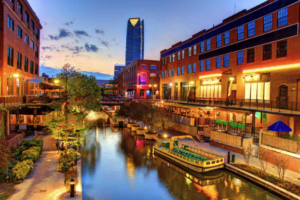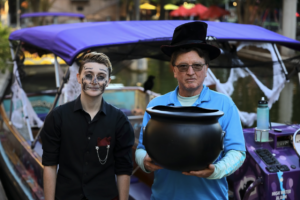
In the heart of Oklahoma City stands a district with a remarkable history of adaptability and growth. This district, known as Bricktown OKC, is a living testament to the economic and social evolution not just of a neighborhood, but of an entire city.
The Genesis of Opportunity
Our story starts in 1889, during the famous Oklahoma Land Run. It was during this event that Bricktown OKC emerged as an economic hub. Its strategic location at the intersection of the Oklahoma railroad station and the Oklahoma River facilitated the movement of settlers and goods to and from distant markets.
At the same time, troops from Fort Reno were stationed in close proximity, overseeing the growth of this bustling settlement. As these troops eventually withdrew, the U.S. Congress directed the city to sell properties in Bricktown OKC for public investment in education and recreation, laying the foundation for the district’s expansion. During these early years, the district’s signature red brick buildings began to take shape, a feature that would later become emblematic of its identity.
The Rise and Fall of Deep Deuce
Adjacent to Bricktown OKC, another community named Deep Deuce came to life. This area became known for its socio-economic diversity and vibrant entertainment scene. Central to this community was Douglass High School, an all-black institution that drew families to settle along First, Second, and Third Streets. This diversity infused the district with vitality.
However, in 1934, during the Great Depression, a fire prompted Douglass High School to relocate. This event led to an exodus of families and marked a turning point for Bricktown OKC. As economic activity dwindled, businesses shuttered their doors.
The Resurgence
After the Great Depression, Bricktown OKC faced further challenges as urban cores across the United States experienced suburbanization. Efforts at revitalization in the 1960s and 1970s largely went unnoticed by developers.
Nevertheless, the 1980s marked a turning point when developers began to recognize the untapped potential of the neglected district. The journey towards revitalization was far from smooth, but by the end of the decade, a critical mass of economic activity had established itself in Bricktown OKC. The district began to gain recognition as a destination for dining and nightlife.
In the early 1990s, Mayor Ron Norick unveiled the first slate of Metropolitan Area Projects (MAPS), funded through a one-cent sales tax approved by voters. This initiative included the construction of the Chickasaw Bricktown Ballpark and the Bricktown Canal, demonstrating the significant impact of investing in quality-of-life amenities.
MAPS to Success
Following the initial MAPS program, Oklahoma City’s public schools received capital investment through MAPS for Kids, and MAPS 3 continued this trend. A noteworthy project in MAPS 3 was the construction of the Paycom Center, a major arena near Bricktown OKC. This arena played a crucial role in showcasing Oklahoma City’s capacity to support an NBA franchise when it temporarily hosted the New Orleans Hornets in the wake of Hurricane Katrina. This also led us to secure the OKC Thunder franchise in 2008, which was a huge help in Oklahoma City becoming a “Big League City”.
Bricktown OKC’s Placemaking Magic
The economic importance of Bricktown OKC is deeply intertwined with the concept of placemaking. Placemaking involves creating quality places that foster a sense of community and connection between people and their environment. Bricktown OKC’s distinctive history, culture, and geography provide a fertile ground for placemaking.
The district’s unique ability to reinvent itself, leveraging its history as
an asset that forges deep connections between people and place, is central to its economic significance. As urbanization continues and Bricktown OKC transforms into a live, work, play district, these connections will deepen, benefitting the entire city.
Economic Geography and Placemaking
Understanding the forces of economic geography that influence Oklahoma City is crucial. These forces include agglomeration, which draws people and production to urban areas, and dispersion, which discourages urban density. Oklahoma City, strategically situated along the I-35 corridor, is poised to benefit from prevailing urbanization trends.
As transportation and transaction costs decrease, firms no longer require proximity to consumers. Instead, they can cluster in urban centers, fostering urbanization patterns. Bricktown OKC’s strategic location along I-35 places it at the forefront of this trend.
The Art of Placemaking
Placemaking encompasses three main types: strategic, tactical, and creative. Strategic placemaking combines form and function to create places where people want to live, work, play, and learn. Tactical placemaking employs a phased approach to enact change. Creative placemaking integrates arts, culture, and creativity into the built environment.
Bricktown OKC epitomizes placemaking with its diverse array of quality places. These include not only various concert venues that promote creativity and artistic engagement, but public art and even live busking on the sidewalks. These quality places forge connections between people and Bricktown OKC’s history and physical environment, enhancing its economic impact.
The Economic Impact of Bricktown OKC
Bricktown OKC’s economic impact is multifaceted. As a live district, it is home to over 250 households with a combined income of $16 million, catalyzing a chain of economic activity. As a work district, it accommodates more than 4,600 workers, necessitating supporting economic activities. Lastly, as a play district, it attracts 1.8 million visitors annually, further fueling economic growth.
In total, Bricktown OKC sustains 9,485 local jobs, generates $501.3 million in labor income, and contributes $1.4 billion to local production of goods and services.
Conclusion
The journey of Bricktown OKC from a thriving economic center to a neglected district, and ultimately to a vibrant live, work, play destination, underscores the power of strategic urban development and placemaking. As Oklahoma City continues its urbanization, Bricktown OKC’s economic influence will deepen, benefitting the entire city. Its story serves as a testament to the fact that history and culture can be valuable assets for economic growth, and the creation of quality places can truly transform a community. Bricktown OKC’s remarkable resurgence serves as an inspiration to urban planners and communities across the nation.

